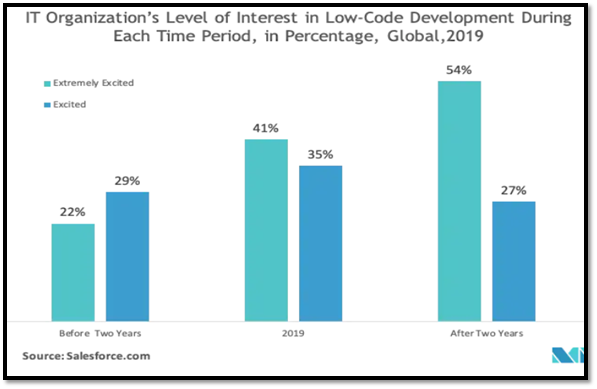Tag: Low Code Trends
In 2020, low code speaks about a movement within technology because, in future, 50%*** of all new business applications will be created with this visual coding tool. If you are not familiar with the term low-code platform for app development, then get ready because you are about to start hearing it everywhere. Global businesses are now creating add-on pressure on developers in demand for multichannel applications to gain competitive advantage. In that scenario, low-code development platforms are accelerating the delivery of business applications with high productivity and offering better customer experience.
The worldwide low-code development platform market generated $10.3 billion revenue in 2019 and is expected to witness a CARG of 31.1% during the forecast period of 2020-2030**. Most of the tech companies consider low-code application platforms because it requires minimal coding and enables faster delivery with the help of pre-packages templates, graphic design techniques, and drag-n-drop tools. Below, three key factors work as driving force in this platform:
- Increasing demand for business digitization
- Less dependency on the information technology
- Stringent government norms on technology adoption

According to the Salesforce.com survey report, over 76%* of IT professionals were profoundly interested in low-code app development, which may scale up to 81% in 2021. More than half of the business is now happening using the low-code programming because developers consider this process viable for the development of the mission-critical application and high-level programming language.

The rapid digital transformation has created a significant impact on major industries like Retail, BFSI, FMGC, E-Commerce, Media, and others. Undergoing process of digitization is a multi-faced journey, and not a single tool or approach will make the transformation to reality. But the bespoke platform can play a central role in the mixed method of digital transformation by reducing the load on IT and accelerating development time than traditional development process. This low-code solution empowers users to build solutions to meet their exact requirements that increase organization agility. This rapid transformation can evaluate the company brand position in this competitive market with a better customer experience.

The ongoing outbreak of COVID-19 is working as an additional fuel on the growth of low-coding platforms. This global pandemic pummels the economy, shredding profits and millions of jobs, now organizations are looking for a new platform to change. In that scenario, low-code automation is helping organizations adapt to massive disruption by quickly combining human and digital labor in the same workflow. COVID-19 has resulted in some of the complex problems mentioned below, for which low-code offers an excellent solution.
- Rapid business transformation in Retail and Healthcare
- Immediate need for applications
- A drastic shift in business strategy models
- Technical debt, and unavailability of talents become burden for companies

This pandemic has forced many small retailers and healthcare organizations to adopt or leverage their online marketing just for survival. Education, Pharma, and other small businesses are now depending on low-code solutions for an immediate need for new software applications. Self-reporting apps on disease symptoms, apps for online classes, government apps for the temporary service are now of outrageous demand. AD&D services in the insurance sector, airlines, retail, and healthcare are in the first row of low-code app demand. Moreover, cost of maintenance and update is quite low in this platform that can reduce company technical debt.
As per the Gartner report, Salesforce, Microsoft, Mendix are the topmost service leaders in fastest-growing low-code environment who have configured the cloud-native deployment options to minimize the operational risk and align organizational needs.

At Inovar, we are fully aware of the benefits of the low-code development platform and have aided one of the biggest healthcare centers in the US. We have helped them to migrate from their existing manual process to a low code solution to help patients amid this global pandemic. It was a comprehensive solution which included, dashboards, online forms where patients can ask any query or find details regarding doctor consultation quickly.
The old way of doing things might not die out completely, but people may be more reliable on low-code platforms as low-code programmers are going to lead the development environment. In a nutshell, in the era of rapid transformation, maybe companies won’t get much time to follow the lengthy development process or reinvent new wheels that can make apps redundant before they are even released. It will be the best time to believe in empowering IT developers and supporting them in creating a whole new ecosystem of application development.
Hence, do not allow yourself to be on the wrong side of history and empower your business with the right trend of the market.
References
* LOW CODE DEVELOPMENT PLATFORM MARKET – GROWTH, TRENDS, FORECASTS (2020-2025), Mordor intelligence, Retrieved from: https://www.mordorintelligence.com/industry-reports/low-code-development-platform-market
** Low-Code Development Platform Market Research Report: By Offering (Solution, Service), Deployment Type (Cloud, On-Premises), Enterprise (Large Enterprises, SME), Vertical (IT, BFSI, Retail, Healthcare, Government, Manufacturing, Media and Entertainment, Education, Energy and Utilities) – Global Industry Analysis and Growth Forecast to 2030, PRESCIENT& STRATEGIC INTELLIGENCE Retrieved from: https://www.psmarketresearch.com/market-analysis/low-code-development-platform-market
How Low-Code Technology Accelerates Digital Transformation Retrieved from:
https://www.businessprocessincubator.com/content/how-low-code-technology-accelerates-digital-transformation/